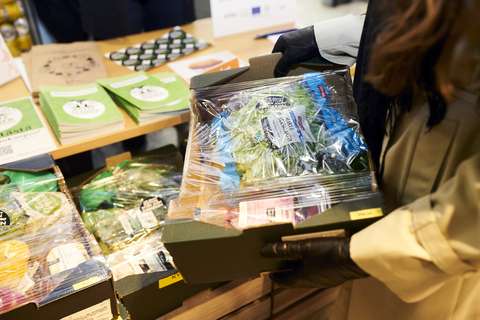Everything circulates in Kera

The new Kera will serve as a model area for circularity. New resource-wise innovations are already being tested in the area.
Published in Länsiväylä 14.11.2020.
On the Surplus Food Day held in October, the customers of K-Market Kilo were provided with advice on how to reduce household food waste. On the day of the campaign, the staff of Tyrsky Consulting were on-site at the shop distributing a surplus food guide and good advice as part of a pilot project.
Finland generates 460 million kilos of food waste annually. Food production, transportation and preparation also cause a great deal of greenhouse gas emissions. When edible food is thrown out, the emissions generated in its production also go to waste.
The shop manager of K-Market Kilo, Kimmo Relander, has done a great deal to reduce the food waste generated by his shop. But there is always room for improvement.
“As part of the Surplus Food Day, we introduced a new sticker that tells customers that a product is approaching its use by date,” Relander explains.
In addition to receiving good advice, customers were able to purchase boxes of surplus food adorned with stickers saying ‘Take me home so I don’t become food waste’ for a discount price of two or three euros.
The Surplus Food Day is one of the experiments carried out in Espoo under the KIEPPI project to promote circularity. Another major circularity project is the development of the city district of Kera, which will eventually not only provide housing for 14,000 and jobs for 10,000 residents, but also serve as Espoo’s model area for circularity. The aim is to create a resource-wise city district where services based on sharing and shared use play a major role.
Project Manager Reetta Jänis and Circular Economy Specialist Mia Johansson, two of the people behind the circular economy experiments being carried out in Kera, are now considering what kind of collaborative waste collection system would be best suited to single family house areas in Espoo. At present, each single family house has its own waste collection bins, but shared use waste collection containers could potentially make recycling more efficient and reduce residents’ waste processing fees.
Waste management regulations are becoming stricter next year, forcing even small housing companies to start sorting their waste. Only properties with less than five housing units are exempt.
“We would like to make recycling easier and offer options for waste sorting even in single family areas that are not subject to the same waste management regulations,” says Johansson.
The City of Espoo and HSY, which is responsible for waste management is Espoo, are now collaborating with a service designer to develop a system in which several neighbouring houses use the same set of waste collection containers, with one house being responsible for an organic waste container, another house being responsible for a paper container, etc.
“The system could be tested in the single family house area of Kera, for example. Another possibility would be for single family houses to use the waste collection bins of planned blocks of flats while covering a part of the costs,” Johansson ponders.
Most circular economy innovations depend on new digital technologies Nokia, the head office of which is located in Kera, has built a 5G network in the area that makes is possible to operate robot buses in Kera, for example. A somewhat more grounded digital experiment is being carried out at the Kierrätyskeskus Reuse Centre in Espoo's Nihtisilta: for a period of six months, the centre is testing a ‘Noutoboksi’ pickup locker, which can be used by people selling items in online second hand communities to deliver sold items to purchasers without risking exposure to the coronavirus.
“I recommend trying it out, the locker can be used completely free of charge until April,” Johansson says, encouraging locals to take part.
Circularity is not just about recycling materials; it is about the efficient use of all other resources as well. Not everything needs to be owned, Johansson points out. Examples of smart sharing economy solutions include the city bikes that have appeared on the streets of Espoo. When public buildings are built in Kera in the future, their facilities will also need to be planned in a way that allows them to be used for multiple purposes.
“Residents will be able to utilise them for their own needs in the evenings, for example.”
Shop manager Kimmo Relander is also excited about the flexible use of facilities. A great example of this is the massive logistics halls located in Kera, which have been temporarily re-purposed awaiting the development of the area. Owned by S Group, the nearly 100,000 square metre halls are becoming a veritable entrepreneurial sandbox: the affordable facilities have attracted entrepreneurs of all kinds to Kera, from urban food production to fitness services.
“The halls can be used for almost anything. It’s a positive phenomenon that we want to be a part of,” Relander says.
As a result, K-Market Kilo now stocks its shelves with some genuinely local products, namely organic sprout salads grown in the halls in Kera and beers brewed by local craft breweries.